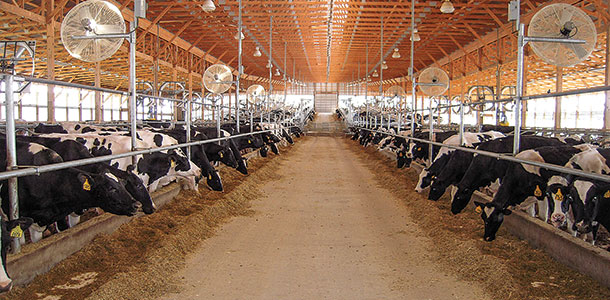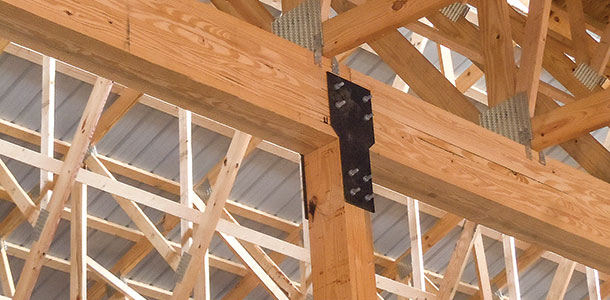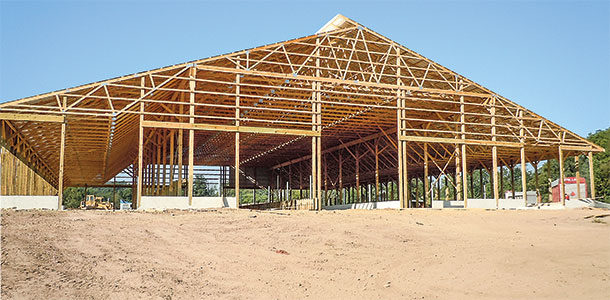Structures that house cattle are vital to the success of a dairy business. It is essential these buildings are able to withstand weather events, have tolerable maintenance costs and contain materials resistant to an interior environment that can be rather aggressive. Buildings need to provide a safe environment for employees and animals, remain in good condition for their functional life, with minimal maintenance, and last (at least) the duration of the loan taken to construct it.
In many cases, agricultural structures have not met the expectations of the owner, as well as their lender and insurance company, due to significant structural damage caused by low-level weather events and premature deterioration of the building materials and equipment.
Historically, agricultural buildings were considered of “low importance,” so structural load reductions of roughly 20 percent could be applied in the design. Modern dairy shelters are larger, continuously populated with cattle and normally occupied by employees daily.
In addition to providing a safe working environment, the building is an essential element of the business and cannot be out of service for even short periods due to structural damage or repair.
Building codes are typically used to guide commercial and residential construction. They are actually design “minimums” developed primarily to protect human life by matching a building’s intended use with appropriate structural design loads. They also provide guidance on non-structural issues such as electrical and plumbing guidelines.
In many areas, agricultural buildings are not required to be code-compliant. No code requirement usually means there are no engineered building prints or structural inspections. Therefore, the owner assumes responsibility for building design.
Agricultural structure failures over the past few years have led some states to require agricultural structures to meet limited code expectations. Whether or not building codes are mandatory, the same loading guidelines required for commercial and residential buildings ought to be applied to agricultural buildings to ensure their structural integrity.
Fortunately, engineering buildings – even agricultural ones – has become rather precise. Available technology can accurately model structural components under different loading scenarios.

Weather event data, along with storm and load frequency, need to be considered to develop worst-case scenarios during a structure’s life expectancy. Low-importance, medium-importance and high-importance design values consider 25-year, 50-year and 100-year storm recurrence, respectively.
Since modern dairy buildings are occupied by humans and animals daily, and their function is essential to business operation, select structural design loading and 50-year recurrence values similar to those used with commercial and residential buildings.
Structural integrity of a building is the sum of its components. Loads move through the assembly of building members and connections and find their way to – or are supported by – the ground. The weakest component determines the overall strength of the system.
Therefore, all structural components must be properly sized and joined to withstand the variety of forces applied to them. For example, a truss assembly may be designed to withstand acceptable snow load, but without adequate bracing and connection to the wall system, failure will most likely occur well before reaching the calculated loading.
The building materials and equipment selected also need to be resistant to the unique dairy shelter environment, typically acidic, created by moisture, manure, urine, bedding and feedstuffs, intent on deteriorating them. Careful attention to ventilation design and management during all seasons to control moisture, gas and pollutant levels in the animal space is essential.
Treated lumber is used in above-ground, at ground level and below-ground applications. The volume of treatment varies for each application with the greatest amount used in below-ground applications. Treatment solutions help resist deterioration, but do not unconditionally prevent it; take precautions to avoid standing water and encourage surface-water drainage away from the building.
Aluminum and steel are the most common roofing materials used on dairy buildings. Builders, suppliers and designers usually have a strong opinion on which is best. Steel is stiffer, but aluminum is more resistant to corrosion. Both materials require proper installation methods to improve their longevity.
Steel can benefit from a protective layer – usually insulation with a good vapor barrier – between the animal space and roof sheets. Shorter sheet length and proper fasteners significantly reduce structural concerns of aluminum. A rigid building frame and end-lap “slip joints” improve life of both aluminum and long-sheet steel installations.

Another area requiring special attention is concrete quality and finish. Concrete can vary with each load, day and time of day, so the person at the “end of the chute” must have the knowledge and experience to recognize these variables and make adjustments to ensure a quality installation.
Flatwork requires a stable, well-drained subsurface as well as the proper thickness and compressive strength to support expected cattle and vehicle loads. Cow alleys need to provide a confident, non-slip surface without causing excessive hoof wear or injury. Replacing concrete can be an expensive, time-consuming task, so take steps to ensure it is done correctly the first time.
Dairy buildings that contain cattle are often damp and dusty. Electrical wiring should meet the National Electric Code (NEC) requirements for agricultural buildings. Switch, junction and outlet boxes – as well as light fixtures – should be made of non-corrosive materials and gasketed.
Dairy buildings should no longer be considered “low-importance” or temporary structures. Their role in the performance, safety and profitability of a dairy business is essential. Unfortunately, sometimes in a competitive bidding situation, corners are cut and lighter or inferior materials are used to lower the package price.
Firm expectations need to be established for the quality of the building and its components. Compare the initial cost of quality-engineered design, building materials and equipment against the expense of excessive maintenance or time and production losses due to building failure. PD
For more detailed information on this topic, view the Penn State Dairy Team “Technology Tuesday” webinar recording.
Kenneth Guffey, P.E., is a sales and engineering manager with Rigidply Rafters Inc.
Photos courtesy Dan McFarland.

Dan F. McFarland
Sr. Extension Educator - Agricultural Engineering
Penn State University






